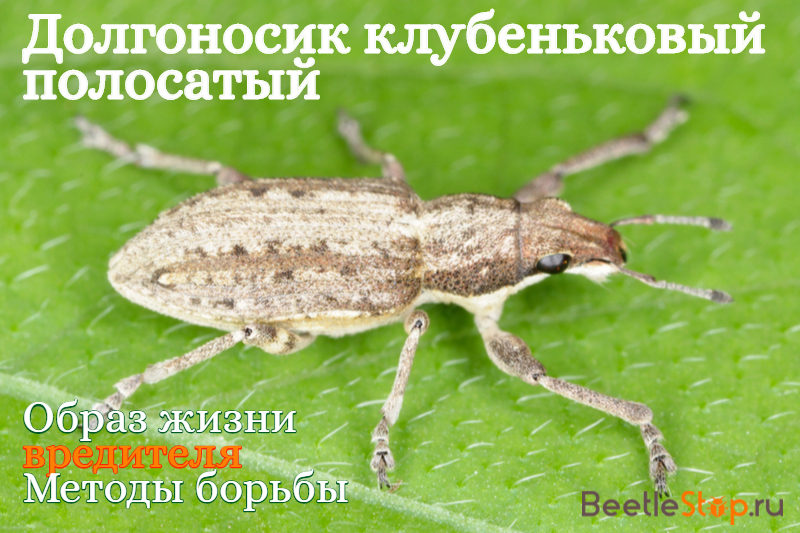Striped nodule weevil - a malicious enemy of legumes
Representatives of the family of weevils are mainly found in tropical zones, but in Russia there are about 5 thousand species. A distinctive feature of beetles is an elongated rostrum, into which the front of the head has turned. Weevil nodule striped is the most common species of its kind. Adults 3-5 mm long are dangerous pests of legumes, the larva feeds on nodules.

Morphological description of the species
Striped nodule weevil (Sitona Lineatus) belongs to the order Coleoptera, the family of weevils. The body of an imago is oblong, covered with short hairs. The length is 3-5 mm. Head with large bulging eyes. The rostrum is wide and short. Antenna articulated with an egg-shaped mace. Pronotum slightly transverse with rounded lateral edges. The main color is dark, the body is covered with gray and red hairs.
Elytra slightly convex, elongated, with protruding shoulder tubercles and a rounded apex. On the elytra there is a clear alternation of brownish and light stripes. Paws and lower legs red with gray setae.
The species is widespread in the Palearctic, found throughout Europe, in the countries of Asia and North America. In Russia, lives in the European part of the country and partially in Siberia. The habitat of the species coincides with the cultivation of annual legumes.
Lifestyle
Beetles hibernate at the adult stage, burrowing into the soil in places where perennial legumes grow. They wake up early, in March-April. They rise to the surface at a steady average daily temperature of + 7-8 °. Migration begins on the population of seedlings of peas, lentils, alfalfa, and beans. At temperatures above + 13 ° the bugs make flights. With a massive invasion and active nutrition, insects completely destroy the shoots of peas and wikis.
Information. Typical damage - gnawing oval holes along the edges of the leaves of the feed plant. Scientists call them "figured eating."
Insect activity occurs on hot sunny days, on rainy and cloudy days they hide and do not feed. After the settlement of the field, nodule weevils lead a sedentary life. Females are more gluttonous; they eat 3 times more males.
Breeding
The breeding season lasts from spring to early summer. Beetles mate on fodder plants, then the female lays eggs in various places: on the stems and leaves of legumes, the soil near the plants. Wherever the masonry remains, it is rained and blown to the ground. The size of the egg is 0.2-0.3 mm, the initial color is yellow, the surface is smooth. Embryo development takes about a week. During this time, the eggs become almost black. The total fertility of the female is 2500-2800 pieces.
Not all eggs mature, they need high humidity and a certain temperature. In dry weather, 80-90% of the masonry dies. At a temperature of + 12 °, the development of the embryo takes a month, at a temperature of less than 7 ° and above 33 ° it completely stops. The mass emergence of larvae occurs at the end of spring. They penetrate the soil and begin to eat nodules. Destruction of nodules negatively affects the amount of nitrogen in the plant and soil.The larva is white, legless, on the body of the bristles. The head is small, brown, with a chitinous cover.
Information. Nodule weevils develop exclusively on legumes. Larvae need nodules and plant roots for development.
The period of development of the offspring takes 30-40 days. During this time, one larva eats 4-7 nodules. Pupation occurs in the soil at a depth of 10-30 cm. After 10-13 days, young adults appear. Beetles for food scatter along the crops of lupine, lentils, wikis.
Methods of struggle
A set of measures is taken against the pest, including agricultural and chemical methods of control.
Agrotechnical events:
- planting agricultural legumes away from wild plants of the family;
- early planting of peas;
- plowing the field after harvesting;
- fertilizer application to accelerate the development of plants.
Chemicals
With a high number of pests (10-15 adults per m2) the field is sprayed with insecticides. Chemical treatment is carried out with the preparations Vantex, Lannat, Zolon, Fufanon. Before planting, the seeds are etched with neonicotinoid insecticides.
A reduction in the number of weevils is caused by the defeat of larvae and pupae by fungi. Harpalus rufipes beetles, Philonthus ebeninus staphilinids, and braconids parasitizing adult bugs are useful entomophages that help control pests.

